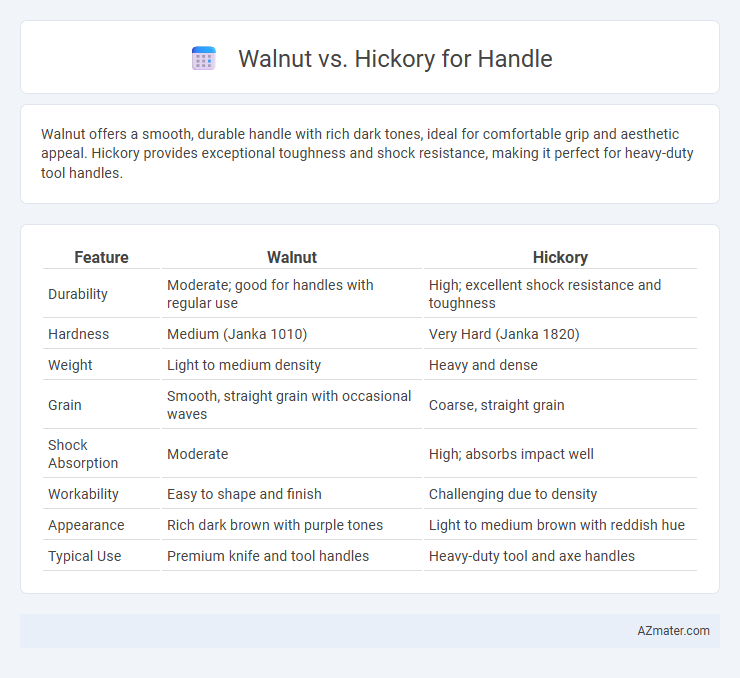Walnut offers a smooth, durable handle with rich dark tones, ideal for comfortable grip and aesthetic appeal. Hickory provides exceptional toughness and shock resistance, making it perfect for heavy-duty tool handles.
Table of Comparison
| Feature | Walnut | Hickory |
|---|---|---|
| Durability | Moderate; good for handles with regular use | High; excellent shock resistance and toughness |
| Hardness | Medium (Janka 1010) | Very Hard (Janka 1820) |
| Weight | Light to medium density | Heavy and dense |
| Grain | Smooth, straight grain with occasional waves | Coarse, straight grain |
| Shock Absorption | Moderate | High; absorbs impact well |
| Workability | Easy to shape and finish | Challenging due to density |
| Appearance | Rich dark brown with purple tones | Light to medium brown with reddish hue |
| Typical Use | Premium knife and tool handles | Heavy-duty tool and axe handles |
Overview of Walnut and Hickory Wood
Walnut wood, prized for its rich chocolate-brown color and fine grain, offers excellent stability and moderate hardness, making it ideal for elegant, durable handles. Hickory stands out for its outstanding strength and shock resistance, characterized by a paler, reddish-brown hue with more pronounced grain patterns, perfect for heavy-use tools requiring robust handles. Both woods combine durability and aesthetics, but walnut emphasizes refinement while hickory delivers superior toughness.
Key Characteristics of Walnut Handles
Walnut handles feature a rich, dark brown color with a smooth, fine grain that offers both durability and an elegant appearance. Known for its shock resistance and comfortable grip, walnut absorbs impact effectively, making it ideal for tool and knife handles. This hardwood maintains stability under varying conditions, ensuring long-lasting performance and a premium feel.
Key Characteristics of Hickory Handles
Hickory handles are prized for their exceptional strength, shock resistance, and flexibility, making them ideal for demanding tools and sports equipment. The dense grain structure of hickory provides durability and the ability to absorb impact, reducing user fatigue during extended use. Unlike walnut, hickory handles offer superior toughness and resilience, contributing to longer-lasting performance in heavy-duty applications.
Strength and Durability Comparison
Hickory handles exhibit superior strength and durability compared to walnut, making them ideal for high-impact tools and heavy use. Hickory's dense grain structure provides exceptional shock resistance and longevity, whereas walnut, though strong, is less resilient under extreme stress. For applications demanding maximum toughness and wear resistance, hickory remains the preferred choice over walnut handles.
Shock Absorption and Comfort
Walnut handles offer moderate shock absorption and a smooth, comfortable grip due to their fine grain and natural oils, which help reduce hand fatigue during prolonged use. Hickory is renowned for superior shock absorption and durability, making it ideal for tools requiring impact resistance, as its dense fibers absorb vibrations effectively. Choosing between the two depends on balancing comfort with heavy-duty shock absorption needs, where walnut excels in user comfort and hickory provides enhanced vibration dampening.
Aesthetics and Appearance
Walnut handles showcase a rich, deep brown color with subtle purples and a tight grain, offering a classic and elegant appearance ideal for sophisticated designs. Hickory handles boast a lighter, golden to reddish-brown hue with a prominent, straight grain pattern, contributing a rustic and rugged aesthetic favored in traditional tools. The choice between Walnut and Hickory handles influences the visual appeal, with Walnut providing a refined, polished look and Hickory delivering a durable, natural charm.
Weight and Balance Differences
Walnut handles are generally lighter, offering a balanced feel that enhances control without adding excess weight, making them ideal for extended use. Hickory handles, known for their density and strength, provide a heavier and more solid grip that improves durability and impact absorption. The weight difference affects balance, with walnut leaning towards a more agile, maneuverable tool, while hickory offers stability and power in each motion.
Maintenance and Longevity
Walnut handles offer moderate maintenance with occasional oiling to prevent drying and cracking, ensuring a smooth, comfortable grip over time. Hickory handles require more frequent care due to their denser grain and susceptibility to moisture damage, but their superior toughness grants exceptional durability and impact resistance. Both woods deliver long-lasting performance, though hickory's enhanced strength often extends handle lifespan under heavy, repeated use.
Ideal Uses for Walnut Handles
Walnut handles excel in applications requiring a balance of strength, comfort, and aesthetics, making them ideal for high-end tool handles, kitchen knives, and fine woodworking instruments. Their natural shock resistance and smooth grain provide superior grip and durability during repetitive use, especially in precision tasks. Walnut's rich color and finish enhance visual appeal without sacrificing functionality, perfect for craftsman-quality handles.
Ideal Uses for Hickory Handles
Hickory handles are ideal for tools requiring high impact resistance and durability due to their exceptional shock absorption and strength. Commonly used in axes, hammers, and other hand tools, hickory provides a reliable grip that reduces user fatigue during heavy-duty tasks. Its natural flexibility and toughness make it preferred for equipment subjected to repeated stress and demanding outdoor work.

Infographic: Walnut vs Hickory for Handle
 azmater.com
azmater.com